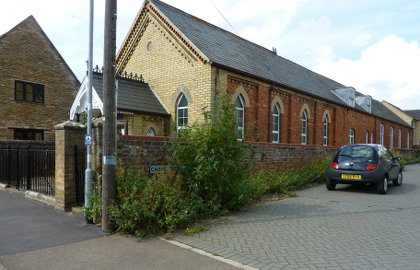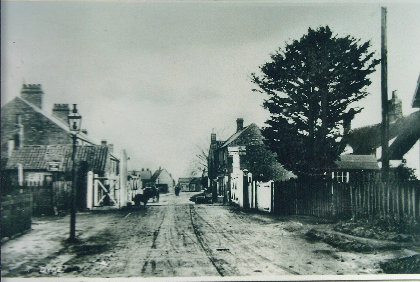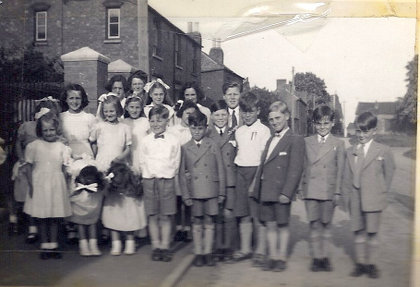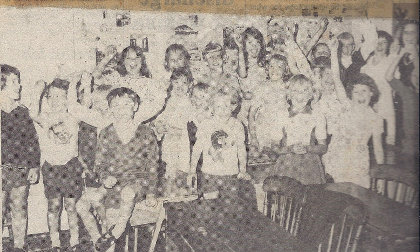Dyke Baptist Chapel
In May 1879 the Baptist Chapel was opened in Dyke. Costing £315 at that time, the money was raised by public subscription and Thomas Wilcox was commissioned as architect. Initially the building was only a chapel, the school room was an additional building added later.
In the Beginning
 It is not uncommon for “time capsules” to be placed under foundation stones of new buildings.
It is not uncommon for “time capsules” to be placed under foundation stones of new buildings.
.
.
It is not uncommon for “time capsules” to be placed under foundation stones of new buildings..
What is less common is the discovery of such a time capsule that had been put in place some one hundred years previously.
Such an occasion occurred in Dyke in 1979 when a sealed bottle that had been laid under a memorial stone at the opening of the Baptist Chapel in May 1879 was discovered. The contents of the bottle were found to be a document detailing the early history of the chapel written by a local farmer Mr Redmile Garner. Also in the bottle was a copy of the General Baptist magazine, a copy of the Freeman newspaper, a poster announcing the order of the opening service, the preacher’s plan and a copy of the Spalding Free Press of the time.
Dyke Baptist Chapel
Prior to building the chapel, villagers had to walk into Bourne to attend a Sunday service. Around 1808 a number of villagers were members of Bourne Baptist church including Mrs William Redmile, John and Molly Foster and Mrs Chantry. Jane Redmile was born in 1800 and spent most of her early years in the cottage of her birth overlooking the village green. By her early twenties she had opened a grocers shop in Eastgate, Bourne. She became concerned about the village children’s religious education. As a result she started having a small group of about 10 children into her house for Sunday School classes. Classes were well organised as a superintendent and regular teachers were involved. The group numbers grew and Mrs Redmile’s kitchen, were the classes took place, was soon outgrown. As a result they first moved to John and Molly Clay’s house then to the house of Mrs Allen who lived near to the village green. Numbers continued to grow and soon it became apparent that individual homes were not able to provide the space needed. In 1843 Mrs Jane Redmile gave £60 of her own money, a substantial sum at the time, to pay for a purpose built schoolhouse. Numbers attending quickly grew and soon reached 80 children. In Victorian England education was greatly valued and as a result in 1865 a school library was started to be built in Dyke. The location chosen for the buildiing was unfortunate as it lay on the path surveyed for the Great Northern Railways new line to run from Sleaford to Bourne. The result was that the school house and new library were demolished in the early 1870’s to make way for the railway which opened its line in 1872. Although no longer in existence as the line closed in 1964, the Gate Keepers Cottage built at the time still remains and clearly denotes the position were the railway crossed the Main Road in Dyke.
Railway Crossing and Gate Keepers Cottage, Main Road, Dyke around 1900.
The members of the Baptist Church who lived in Dyke continued to make the two mile journey on foot to worship at the Chapel in West Street, Bourne. They appear to have been determined and enthusiastic regarding there religious beliefs as it soon became apparent they had set their sights on building a chapel of their own in Dyke. As a result Mr Benoni Gilbert bought a plot of land central in the village from John Wilcox for the sum of £17. On October 15th, 1878, a memorial stone was laid denoting the start of building the new chapel. Money for the building was raised by public subscription and Thomas Wilcox was commissioned as architect. Local builders Messrs Wilcox and Son were given the job and completed it at a cost of £315. The chapel was opened the following year in May 1879. Initially the building was only a chapel but there was a need for a purpose built school room. As a result further funds were raised and an extension was built at the rear of the chapel which became the school room which opened in 1895. Final cost of the chapel and furniture came to £421/3/2 of which £202/12/11 was collected and paid by public subscriptions.
School room built in 1895 as an extension at rear of Baptist Chapel.
The Chapel in use
The village had bought and paid for its chapel and school room, now they could have the pleasure of using them.
The school room building is hidden from view at the rear of the chapel. It proved to be a success as it provided a permanent location for the thriving Sunday School that existed at that time. Whilst continuing as a Sunday school, the building was leased as a State Primary School having the same managers as Bourne County Primary School.
Presentation to school teacher Miss Darnes (centre) on her retirement from Dyke School in 1947.
She had been responsible for the Elementary class.
The building contained one large classroom with pale grey walls, yelllow ceiling and woodwork. It is separated at one end by a glass-topped partition from the dinner room and at the opposite end is an indoor cloakroom with wash basins. Outside there was a large tarmac playground to the rear of the building that provided ample space for the twenty four children that were registered at the school. The old playground area is now the housing development called Chapel View.
Originally opened in 1896 as Dyke Board School it had 38 pupils on its register. At that time the school had a Headmistress and a monitress who managed the school affairs and provided education for the children. In 1929 over seventy children attended the school all catered for in the single and overcrowded classroom which was only suitable for thirty children. Overcrowding was to get worse. During the years of the second world war about forty children, mainly boy’s, were evacuated to Dyke from West Dock Avenue School, Hull. These children were accompanied by their teacher Mr Kirkby and his wife who stayed at the Fenney’s house.
Children evacuated from Hull to Dyke during World War II.
- Frank Andrews who stayed with Mr J.C.Ash.
- Robert Allison who stayed with Mrs Jackson.
- Michael Crane who stayed with Mrs Waters.
- George Page who stayed with Mrs Gray.
- Alan Page who stayed with Mrs Gray.
- Enid Allison who stayed with Mrs Sommerfield
- June Bishoprick who stayed with Mrs Lilley
- Neville Gray who stayed with Miss Bracegirdle
- Ramon Glover who stayed with Mrs C.H.Smith
- Ernest Louth who stayed with Mrs Garrill
- Terence Lound who stayed with Mrs Burton
- George Rangely who stayed with Mrs Summerfield
- Cyril Foot who stayed with Mrs Garfoot
- Richard Baker who stayed with Mrs Leverton
- Albert Robert Firth who stayed with Mrs R.H.Ash
- Charles Hazell who stayed with Mrs J.H.Ash
- William Higham who stayed with Mrs Hallam
- Alan Naules who stayed with Mrs Wass
- Arthur Saverton who stayed with Mrs Moon
- Eric Precious who stayed with Mrs Batterham
- Albert Stevens who stayed with Mrs Burrows
- Albert McArthy who stayed with Mrs Skeet
- Charles Andrews who stayed with Mr J.C.Ash
- Charles Bishoprick who stayed with Mrs Lilley
- Abednego Soulsby who stayed with Mrs Wright
- Fred Stamp who stayed with Mrs Stubbs
- Peter Davis who stayed with Mrs Pollard & Mrs Cooper
- George Lyons who stayed with Mrs Lilley
- Roy Turgoose who stayed with Mrs Knighton
- Norman Sheperdon who stayed with Mrs Reed
- Brian Glover who stayed with Miss Bracegirdle
- William Stamp who stayed with Mrs Needham
- Brian Stamp who stayed with Mrs Needham
- Harold Hudson who stayed with Mrs Wright
- Fred Lacey who stayed with Mrs ClarkLionel Russell who stayed with Mrs CowardDoreen Russell who stayed with Mrs Roughton
- Elizabeth Lyons who stayed with Mrs Lilley
- Arthur Thornham who stayed with Mrs Reed
- Freda Sheperdson who stayed with Mrs Lilley
- June Sheperdson who stayed with Mrs Lilley
- Peter Marshall who stayed with Mrs Pearson
- Pearl Scaum who stayed with Mrs Pearson
- Brian Glover who stayed with Mrs C.H.Smith
At that time the school catered for two age ranges; 5-9 years and 9-14 years with forty plus in each class. It must have been a serious problem to keep the 30 or so village children plus 40 child evacuees in order whist managing their education in a school built to house only 30 pupils. It is a credit to both teachers and children that all survived in some semblance of order whilst receiving an education. Until 1948, well after the war years, the school was an all-age school manged and run by two teachers, one being Mrs Hallam. After that date it became a primary school with pupils sitting an 11+ exam to determine which Bourne secondary school they would attend.
The school day began at 9am with infants leaving at 3pm and the junior children half an hour later. Nineteen out of the twenty four pupils stayed for school dinner which were cooked in Bourne and transported daily by road. The school prided itself in the success it had achieved in the Bourne and District Primary School Sports. It won the Infant Achievement Shield a total of 6 times, awarded for the highest number of points gained. In 1965 they won the Junior Achievement Shield for the ninth time. This was an impressive record considering it was such a small village school.
Children from Dyke Sunday School celebrate their anniversary outside the Baptist Chapel gates 1952.
By the 1970’s the school was under pressure to close and a “Save our School” action group was formed that succeeded in getting almost all of the 300 inhabitants of the village to sign a petition in support of the campaign. In 1975 the school appeared to have won its fight. In the meantime the nearby school at Bourne Fen serving Twenty was to close. Its 15 pupils were being relocated to Bourne County Primary school. The petition from Dyke was sent to Mrs Margaret Thatcher, Minister of Education at the time, and a copy to local MP Mr Kenneth Lewis. In 1975 the Department for Education and Science announced it would not be closing the Dyke school.
Dyke school pupils celebrate hearing the school will remain open. 1975.
The celebrations were short lived and by the late 1970’s it was announced that the school in Dyke would close with pupils moving to Bourne County Primary School a distance of over two miles away. The school room remains and is still in use including rehearsal rooms for a local Amateur Dramatics group. It is pleasing to note that the chapel remains and is used on a regular basis by local people for worship.
In researching this page reference was made to the following:
A Portrait of Bourne by Rex Needle.
Welcome to Spalding: The village of Dyke. visitorsuk.com
Dyke WI Village Scrapbook 1965
Conversation with Mr Charles Hazell from Hull who was evacuated to Dyke aged 9 years and lived with the Ash family during WWII
Evacuee list provided by Charlotte Allison
More About:
Dyke WI
The Windmill in Dyke
Dyke Baptist Chapel
Dyke Village Green
Dyke Village Hall
Dyke Engine House
The Railway in Dyke
The Wishing Well Inn
The Car Dyke
Dyke Village Life
Contact Dyke Village Hall
Main Road, Dyke, Bourne, PE10 0AF
Email: contact@dykevillagehall.org.uk






